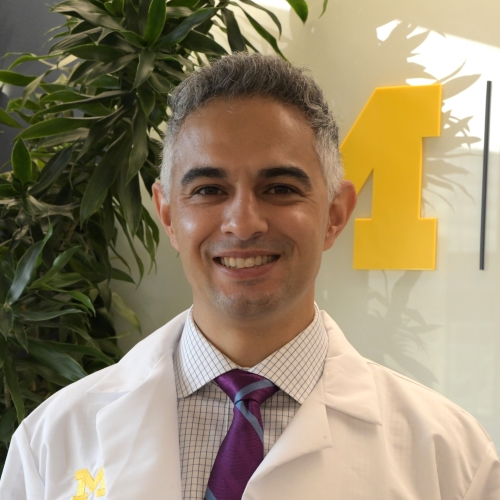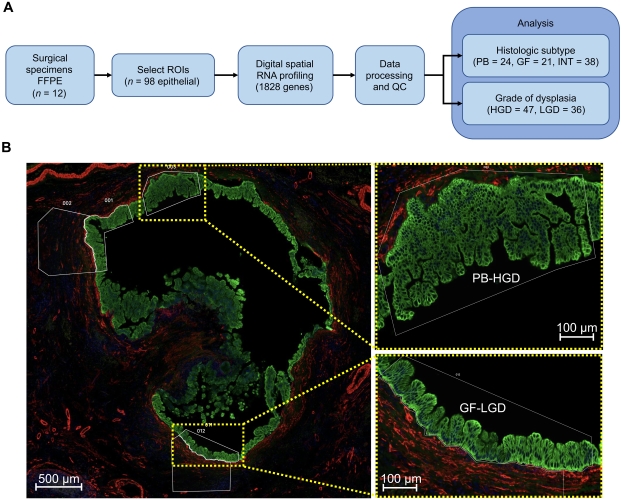By Lynn McCain
 There are times in many people’s lives that can be called defining moments. Moments when their lives suddenly take a turn, and the entire trajectory of their lives change. This was true for Matthew Iyer, MD, PhD, Assistant Professor of Surgery and Pathology.
There are times in many people’s lives that can be called defining moments. Moments when their lives suddenly take a turn, and the entire trajectory of their lives change. This was true for Matthew Iyer, MD, PhD, Assistant Professor of Surgery and Pathology.
A Colorado native, Iyer was “raised by a statistics professor and a math major” and became immersed in computer programming and science projects as a child. After high school, he enrolled at the University of Colorado at Boulder and completed dual degrees in Electrical and Computer Engineering and Music. “I never thought I would become a doctor. But my plans changed.” In his senior year of college, Iyer endured a tragedy that became a defining moment in his life. “My younger brother and I were hiking in the Rocky Mountains, and he suffered a tragic fall and died,” he explained. “I graduated and began my PhD in Electrical Engineering, but as I reflected on my brother, I decided to change course quite dramatically. I was then a teaching assistant in Electrical Engineering and used my free tuition privileges to complete my premedical course requirements.”
To Iyer’s surprise, he loved the pre-med courses and committed to apply to medical school. “My whole perspective changed. I went on to enroll in the Medical Scientist Training Program (MSTP) at Michigan and completed my PhD in Bioinformatics.” For his PhD studies, Iyer joined the laboratory of Dr. Arul Chinnaiyan, who leads the Michigan Center for Translational Pathology. In the laboratory, he focused on the analysis of high-throughput RNA sequencing data from tumors to discover genes implicated in cancer progression. Iyer’s research allowed him to utilize the extensive computational experience he had gained from his studies in Colorado and his research pursuits evolved into “a calling”. “I knew with certainty that I needed research to become the main focus of my career.”
After his medical school clerkships, Iyer gravitated towards surgery. “Becoming a surgeon was probably the last thing on my mind. I chose to do my surgery clerkship first because I thought it would be nice to get it over with. But I ended up loving it.” Iyer went on to complete general surgery residency at New York Presbyterian - Weill Cornell Medical Center followed by Complex General Surgical Oncology and Hepatopancreatobiliary Surgery fellowships at Duke University. He plans to focus on pancreatic cancer and other abdominal malignancies in his evolving practice.
When Iyer was invited to become a member of the surgical faculty, he also wanted to rejoin the Chinnaiyan lab to continue his research. As such, he was recruited to a joint appointment with both Surgery and Pathology in October 2023. In his clinical role, he spends two days each week working at the Ann Arbor Veterans Affairs Hospital as a general surgeon and “I find that to be extremely gratifying. I love the staff, the residents, my partners, and especially the patients. I would be happy to continue at the VA for the rest of my career.”
In terms of research, Iyer has three primary projects on which he is working. The first is developing liquid biopsies to detect and monitor cancer. He is investigating using circulating RNA in the bloodstream to detect, monitor, and characterize cancers without invasive biopsies. “While circulating tumor DNA has been the primary focus of liquid biopsy research, RNA offers compelling advantages, such as the ability to measure cancer-specific genes and tumor immunity. DNA and RNA may ultimately provide complementary rather than redundant information.” Currently, Iyer is collecting blood samples from patients with different cancers, including pancreatic cancer, cholangiocarcinoma, prostate cancer, and others. He is developing and testing different protocols for isolating RNA. “We are converging on a protocol for RNA liquid biopsy that we can perform at scale,” he explained.
 In his second research project, Iyer characterizing tumor tissues using spatial transcriptomics. With these platforms, regions within a tumor can be isolated, measured, and compared. “Prior to spatial transcriptomics, we could look at single cells, but those cells would be disoriented in terms of space. You wouldn’t know which cells were next to other cells.” In cancerous tumors, there are often different types of cells within the same tumor. “The cancer may have areas where the cells are behaving aggressively or invading. There are other areas that look indolent. They don’t look like they would be an aggressive cancer that would metastasize. These different areas can exist within a single tumor. We can now study these tumors and better understand how the cancer evolves.” Iyer’s research in this area was published in 2023 in Science Advances, describing their initial use of the platform to study precancerous pancreatic cysts. This research uncovered genes that distinguish high grade from low grade cysts. This could change the patient’s treatment plan as surgery is appropriate for the high-grade cysts but may not be for low grade cysts.
In his second research project, Iyer characterizing tumor tissues using spatial transcriptomics. With these platforms, regions within a tumor can be isolated, measured, and compared. “Prior to spatial transcriptomics, we could look at single cells, but those cells would be disoriented in terms of space. You wouldn’t know which cells were next to other cells.” In cancerous tumors, there are often different types of cells within the same tumor. “The cancer may have areas where the cells are behaving aggressively or invading. There are other areas that look indolent. They don’t look like they would be an aggressive cancer that would metastasize. These different areas can exist within a single tumor. We can now study these tumors and better understand how the cancer evolves.” Iyer’s research in this area was published in 2023 in Science Advances, describing their initial use of the platform to study precancerous pancreatic cysts. This research uncovered genes that distinguish high grade from low grade cysts. This could change the patient’s treatment plan as surgery is appropriate for the high-grade cysts but may not be for low grade cysts.
Finally, Iyer is assembling a large database of RNA sequencing data from different diseases and populations. “There is a tremendous amount of publicly available data that we can use to test existing hypothesis or to discover new phenomena.” But accessing that data is cumbersome. “You need expensive computational systems to download, analyze, and store the data.” After this, the results must be interpreted, which requires specific expertise. Iyer has built a system that can download and analyze RNA sequencing data from the major public archives in a single command. His goal is to make the database available, so that anyone studying a disease could quickly obtain reliable results. A major challenge with this project is the explosive volume of data being produced, and creating a solution that can keep up with the exponential growth in the field is an ongoing challenge. “I’m very excited about that challenge, and I am working on a solution that will stand the test of time.”
In addition to research, Iyer aims to expand his surgical skills so that he can provide the best possible care to his patients. He has adopted the DaVinci robotic platform for many of his operations and believes in the future of robotic surgery. In addition, he wants to give back to the medical school and students in education and other ways. Outside of work, “I am so grateful to have a wonderful family. My wife is an ophthalmologist who inspires me by her kindness and dedication to her patients. We have a 2-year-old baby girl, and we are expecting a second baby in July. Being a supportive father and husband is more important to me that any career goal.” In addition to spending time with his family, Iyer enjoys playing piano for his wife and daughter, and getting outdoors for exercise and leisure.
Citation:
Matthew K. Iyer et al. Digital spatial profiling of intraductal papillary mucinous neoplasms: Toward a molecular framework for risk stratification. Sci. Adv.9,eade4582(2023).DOI:10.1126/sciadv.ade4582
